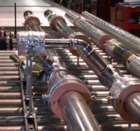Thinking off site

Avoiding hot working — Cal Bailey.
There are many benefits in taking the assembly of piped services off site, as Cal Bailey explains.The use of off-site manufacturing has become much more widespread across the construction industry over the last 10 years, but in exploiting some areas of this innovative way of working, we still have a long way to go. Prefabrication is widely used when constructing the fabric of building, but the same cannot be said for the use of off-site techniques for building services. In fact, as few as 25% of new commercial construction projects incorporate it. Installing building services in the traditional way is complex, with many interfaces needed on-site to install the various components. The off-site approach adds value in terms of reduced risk, reduced on-site labour and less waste, whilst increasing productivity and profitability. One of the main benefits in taking services work off-site is the reduced amount of hot working or welding needed on-site.
Pitfalls Hot working comes with many pitfalls. It heightens the health-and-safety risk on a project, can cause an increased fire hazard and also has significant implications when looking at the Control of Substances Hazardous to Health (COSHH) regulations. The methodology of hot working on-site includes the use of an abrasive wheel to cut the length of pipe needed, which in turn causes sparks. The work therefore has to be carried out in a controlled environment, which can make the building site less productive. Equipment also has to be moved around as and when it is needed, again adding to the work load and conflict between interfaces, thus creating a further H&S risk. If the pipework then needs to be welded in place, there are similar risks. So, why would the preparation of pipework be better carried out off-site? There are several reasons. An off-site factory provides a controlled environment set up for pipework. An abrasive wheel is not used; instead a rotary wheel cuts all sizes of pipe to the length needed as it rotates, and there are no sparks. Off-site manufacture also avoids the need for welding, as a press-fit system is generally used to crimp pipes together. Operatives use a premanufactured sleeve to crimp the pipes in place creating a full seal. Ensuring the seals on the pipework are perfect requires operatives who are trained to follow quality procedures. This system comes with the added benefit that all the work is fully traceable back to the individual who worked on it. Each module has a serial number, which is traceable to who assembled it. Furthermore, the site team will receive a drawing detailing where each module fits into the design to make it easier for the on-site operatives to install.
 |
An off-site factory provides a controlled environment set up for pipework. |
Benefits This type of off-site manufacture brings with it many benefits. There is an obvious reduction in the H&S risk on a construction project, as well as cost and time savings on-site. It also reduces the number of workers needed to fit systems in place, and therefore can also benefit in terms of reduced build times. In addition, waste is reduced and less equipment is needed on-site. An example of best practice is the work carried out by Bailey Off-Site on the PFI hospital project at St Helen’s. When considering the construction of this project, the Taylor Woodrow strategic alliance partnership (SAP) ensured that all key decision makers were involved from the outset and that all were committed to the use of off-site for the entire project. As the building-services provider on the project, NG Bailey was involved in the entire planning process from day one — as opposed to a more traditional approach which would have required involvement only from a post-design phase. This approach ensured the early, detailed and complete design and planning for a whole array of off-site technologies being embedded into the initial design — piped services being just one of them. Over 72 km of pipe and ductwork has been manufactured off-site for this project. Utilising an integrated off-site approach on the PFI project, has resulted in a substantial site labour reduction compared to the traditional method.
Integrated approach The opportunity to increase the use of off-site piped services shows that as an industry we need to close the current disconnect between concept, design and delivery by taking a more integrated approach at the upfront stage. The foundation for this is early involvement. The more off-site manufacture that is used in commercial construction in the future, the less we will see of traditional hot working, which in the NG Bailey view can only be a good thing.
Cal Bailey is director responsible for off-site at NG Bailey.
Related links:
Related articles:




